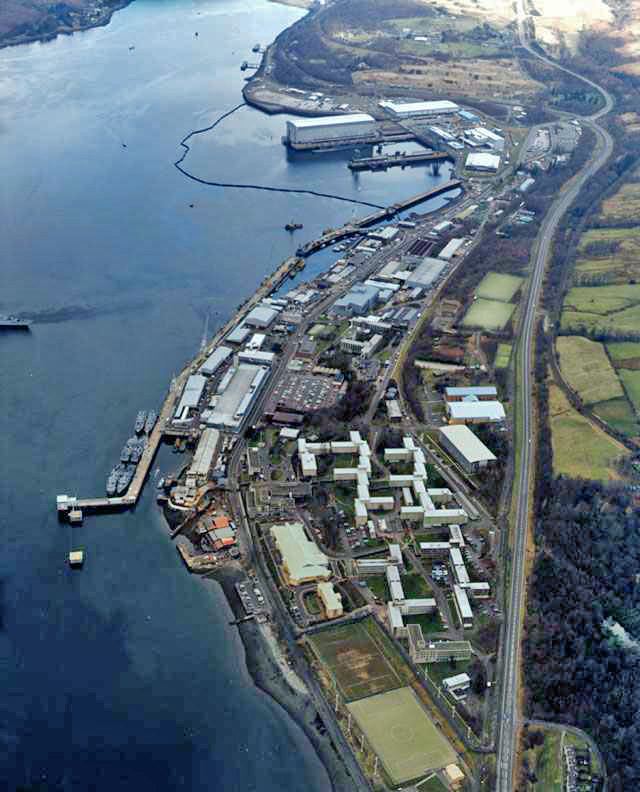Type Commando | Size 790 personnel | |
 | ||
Active 1943–19461961–19681980 – present Role Force protectionMaritime Interdiction OperationsNuclear Security | ||
The 43 Commando Fleet Protection Group Royal Marines (43 Cdo FP Gp RM), formerly Comacchio Company Royal Marines (1980–1983), Comacchio Group Royal Marines (1983–2001) and Fleet Protection Group Royal Marines (2001–2012), is a 790-man unit of the Royal Marines responsible for guarding the United Kingdom's Naval nuclear weapons and other security-related duties. It falls under the authority of 3 Commando Brigade.
Contents
Second World War
Early Commando units were all from the British Army but by February 1942, the Royal Marines were asked to organize Commando units of their own, and 6,000 men volunteered.
43 Commando was formed in July 1943 after the decision was made to convert the battalions of the Royal Marine Division into commando units. The initial intake of personnel was drawn from the 2nd Battalion, Royal Marines, and following commando training at Achnacarry in Scotland, the unit consisted of about 450 men organized into a headquarters, five infantry troops consisting of three officers and 63 other ranks, along with a heavy weapons troop—armed with Vickers machine guns, 3-inch mortars and 6-pounder anti-tank guns—and a signals platoon.
Along with No. 2, No. 9 and No. 40 (Royal Marine) Commandos, 43 Commando formed the 2nd Special Service Brigade. Throughout the course of 1943–45, No. 43 (Royal Marine) Commando served in Italy, Yugoslavia and Greece.
Victoria Cross
Corporal Thomas Peck Hunter was posthumously awarded the Victoria Cross for his actions during Operation Roast at Lake Comacchio, Italy during the Second World War. Hunter cleared a farmhouse containing three Spandau machine-guns on his own, firing a Bren Gun from his hip. Hunter then proceeded to draw enemy fire until most of his troop had taken cover. The Commanding Officer, Lt Col Ian Riches RM was also awarded the DSO in this action. He went on to be Commandant General Royal Marines between 1959 and 1962.
Re-forming
43 Commando RM was reformed between 1961–1968 for "as a further contribution to the forces available for seaborne operations".
On 1 May 1980, the Comacchio Company Royal Marines was formed to guard the UK's Naval nuclear weapons and as a Maritime Counter-Terrorism unit for offshore installations, including oil rigs and ships. The Comacchio Company RM initially numbered around 300 personnel.
Taking its name from a Second World War battle honour, the Comacchio Company's purpose was deemed inappropriate for a Commando-level specification. Instead, the Comacchio Company was named after a battle fought in Comacchio, Italy, by Royal Marines in 1945, where Corporal Thomas Peck Hunter of 43 Commando posthumously received the Victoria Cross for his actions. On its formation, Comacchio Company took on the colours and traditions of the-then defunct 43 Commando.
The Comacchio Company RM became Comacchio Group RM in November 1983 to reflect a manpower increase to over 400 Royal Marines. From 1987 onwards, Comacchio Group also ceased performing the Maritime Counter-Terrorism role, after a study transferred the task to the newly formed M-squadron of the Royal Marines Special Boat Service.
The Comacchio Group RM was renamed Fleet Protection Group Royal Marines in March 2001, and was restructured into its current organisation. The Group also moved from RM Condor in Arbroath Angus (where it was co-located with 45 Commando) to HM Naval Base Clyde, which is situated near Helensburgh, Argyll and Bute (both in Scotland).
In 2004, rifle squadron P was renamed S squadron and the Group was further expanded to a complement of 530. In 2012, FPGRM formally adopted the name 43 Commando.
In 2016, it was announced that the whole unit would be using the Colt Canada C8 carbine instead of the standard L85A2.
Fleet Protection Group
43 Commando Fleet Protection Group Royal Marines
Tasks and organisation
As of 2009, the Fleet Protection Group has over 550 personnel and is organised into several sub-units:
The Group currently performs several tasks, including:
Only a proportion of squadron manpower is deployed at any one time, with the remainder taking leave, courses or training. When not on duty, the squadron conducts field firing, mountain training and other sub-unit training. It is also liable to be deployed on exercises such as Exercise Trade Winds (in the Caribbean), to take part in November Ceremonies at the Cenotaph in London, or conduct cross-training with the USMC during the biannual Exercise Tartan Eagle.
FPGRM is responsible for running the selection process for Royal Marines who wish to join the UK's Special Forces Support Group.
Royal Navy Reserve Augmentation
Naval ratings of the Royal Naval Reserve have been attached to the Fleet Protection Group to support the force protection tasks outside of the United Kingdom.
